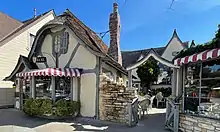| Garden Shop Addition | |
|---|---|
 Garden Shop Addition | |
| Location | Dolores Street btwn. Ocean & 7th Ave., Carmel-by-the-Sea, California |
| Coordinates | 36°33′17″N 121°55′26″W / 36.55472°N 121.92389°W |
| Built | 1931 |
| Built by | Hugh W. Comstock |
| Built for | Pedro J. Lemos |
| Original use | Garden shop |
| Current use | Retail store |
| Architect | Hugh W. Comstock |
| Architectural style(s) | Craftsman |
 Garden Shop Addition Location of Garden Shop Addition in Carmel, California | |
The Garden Shop Addition is a historic Craftsman commercial building in downtown Carmel-by-the-Sea, California. The kiosk was designed and built in 1931, by master builder Hugh W. Comstock, and is adjacent to The Tuck Box and the Lemos Building. The shop was designated as a significant commercial building in the city's Downtown Historic District Property Survey, and was recorded with the Department of Parks and Recreation on October 8, 2002.[1] The building is occupied by Exclusive Realty.
History

The Garden Shop Addition is a one-story, polygonal shaped shop that shares a courtyard with the Tuck Box and the Lemos Building. It is connected on the south side to the El Paseo Building. It is a Craftsman style commercial building with a shingle roof with a candy-stripe awning. Carmel stone was used around the bay window, which extends into the arched stone gate that leads into the courtyard. The building has multi-pane windows at four sides of the polygonal walls, with a Dutch door that leads inside. The shingles and stone tie the design into the rest of buildings in the courtyard.[1]

Pedro J. Lemos (1882-1954), director of Stanford Museum and Art Galleries, bought the Art Shop (later called Tuck Box) and adjacent property from Ray C. De Yoe in 1927. Lemos's vision of the space was to fill it with unique shops and studios reminiscent of medieval shops in the "old world cities."[2]
In April 1929, Lemos designed a fairy-tale cottage for himself, based on Hugh W. Comstock's Tuck Box design, in the rear of the property, that Louis Anderson built for $1,000 (equivalent to $17,043 in 2022). It was called the Lemos Building,[1][3] or Garden Shop. The shop sold flowers, plants, and garden tools.[4][5][6][7]
In November 1931, Lemos built a separate kiosk like addition to the Garden Shop that was constructed by Hugh Comstock for $475 (equivalent to $9,140 in 2022). It is known as the Garden Shop Addition and is between the Tuck Box and the El Paseo Building on Dolores Street. When it first opened it sold cut flowers, gift plants, and pottery.[1][8][9]

In 1932, the Tuck Box was the Tyler Book Shop that sold new and old books, some of which were displayed in the three-sided bay window. To the right of the shop was the Blue Bird Tea Garden, and the Garden Shop Addition had a sign that said "The Garden Shop Flowers Plants Pottery."[10] There was also the Blue Bird Tea Room, that became a popular restaurant located on Ocean Avenue and Lincoln Street.[11]
The Garden Shop Addition qualifies for inclusion in the Downtown Historic District Property Survey as work doen by Hugh W. Comstock who established the Fairy-Tale Storybook Craftsman tradition in Carmel in the 1920s. The Garden Shop Addition is a fair example of this style, with the three-sided bay window, Carmel stone, and shingled roof. It blends in with the other buildings, within the stone gate and walled couryard. These buildings are internationally associated with the city of Carme-by-the-Sea.[1]
See also
References
- 1 2 3 4 5 Richard N. Janick (October 8, 2002). "Department Of Parks And Recreation" (PDF). National Park Service. Retrieved April 5, 2022.
- ↑ Pedro J. Lemos (February 25, 1027). "Keep Carmel Natural And Unveneered, Stanford Curator of Art Will build Medieval Shops on Properties Here". Carmel Pine Cone. Retrieved April 18, 2022.
- ↑ Seavey, Kent (2007). Carmel, A History in Architecture. Carmel-by-the-Sea, California: Arcadia Publishing. pp. 106–107. ISBN 9780738547053. Retrieved 2022-04-16.
- ↑ "Thirty Years Of Carmel". Carmel Pine Cone. December 12, 1929. p. 4. Retrieved April 18, 2022.
- ↑ Metzger, Elizabeth (1979). The breakfast book: where to find the best breakfasts and brunches in northern California. San Francisco, California: Chronicle Books. ISBN 9780877011293. Retrieved 2022-04-18.
- ↑ Hale, Sharron Lee (1980). A Tribute to Yesterday: The History of Carmel, Carmel Valley, Big Sur, Point Lobos, Carmelite Monastery, and Los Burros. Santa Cruz, California: Valley Publishers. p. 100. ISBN 9780913548738. Retrieved 2022-04-18.
- ↑ Dramov, Alissandra (2019). Historic Buildings of Downtown Carmel-by-the-Sea. Carmel-by-the-Sea, California: Arcadia Publishing. pp. 79–80. ISBN 9781467103039. Retrieved 2022-04-20.
- ↑ "Flower Shop Gets Artistic Quarters". Carmel Pine Cone. December 12, 1931. pp. 4, 8. Retrieved April 20, 2022.
- ↑ Mathewson, Joanne (1998). The fairy tale houses of Carmel. Carmel-by-the-Sea, California: Tuck Box. OCLC 53232105.
- ↑ "Announcing The Opening of the Tyler Book Shop". Carmel Pine Cone. 1932-01-29. Retrieved July 2, 2022.
- ↑ Dramov, Alissandra (2022). Past & Present Carmel-By-The-Sea. Charleston, South Carolina: Arcadia Publishing. p. 37. ISBN 9781467108980. Retrieved 2023-03-08.